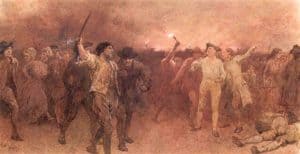The Gordon Riots
Conditions in cities in Britain in the second half of the 18th century were unsanitary and overcrowded. High taxes, unjust and repressive laws, government profiteering and impressiveness in the army and navy were among the issues that inflamed the working classes and bred discontent. Civil disorder bubbled just under the surface of British society, waiting for a reason to explode.
The fuse was lit in 1780 when Lord George Gordon called for the repeal of the Catholic Relief Act of 1778 and a return to the repression of Catholics.
The 1778 Act had repealed harsh anti-catholic legislation from the 17th century and excused Roman Catholics from swearing the oath of allegiance (with its implicit recognition of the Church of England) on joining the army.

The Gordon Riots 1780
This idea of tolerating Catholics was deeply resented in protestant England, however, and on 2 June Gordon led a crowd of 60,000 to the House of Commons to present a petition stating that the legislation encouraged ‘popery’ and was a threat to the Church of England.
Anti-catholic riots ensued in London, lasting for many days, as the masses vented their anger.
Protests were violent and aimed at catholic targets, such as homes and chapels, and a distillery owned by a catholic in High Holborn. They also seem to have expressed a more general frustration: prisons and the Bank of England were attacked.
With no regular police force, the army, including both the 3rd and 4th was called in to restore order and King George III issued a proclamation to suppress rebellion in the kingdom.

